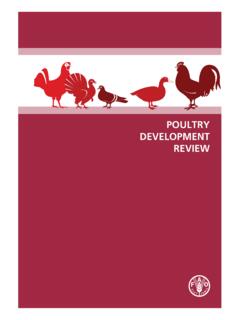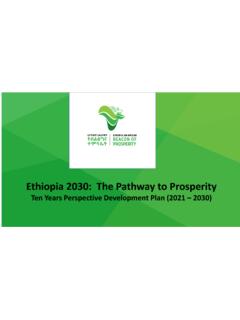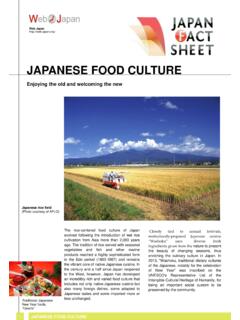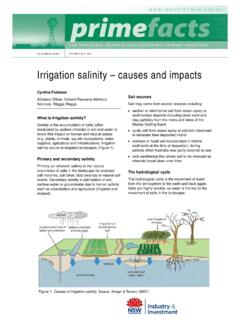Transcription of Climate impacts on food security and nutrition - MAHB
1 Climate impacts on food security and nutritionA review of existing knowledgeExecutive Summary 31. Introduction 42. Climate change 8 Long-term Climate change 8 impacts of sea-level rise and remote Climate 9 impacts of extreme weather events 113. Climate impacts on food security 15 Climate change and food production 15 Climate change impacts on food access and livelihoods 16 Climate change impacts on nutrition and utilisation 174. Uncertainty and evidence-based planning 195. Conclusion 206. References 21 Contents2 Climate impacts on food security and nutritionClimate impacts on food security and nutritionExEcutivE summaryAmong the most significant impacts of Climate change is the potential increase of food insecurity and malnutrition. The aim of this primer is to summarise the current state of knowledge on the impacts of Climate change on food security and change exacerbates the risks of hunger and undernutrition through two main mechanisms:Extreme weather eventsUnder Climate change, the frequency and intensity of some disasters such as droughts, floods and storms could increase, with an adverse impact on livelihoods and food security .
2 Climate -related disasters have the potential to destroy crops, critical infrastructure, and key community assets therefore deteriorating livelihoods and exacerbating poverty. Long-term and gradual Climate risksSea-level will rise as a result of Climate change, affecting livelihoods in coastal areas and river deltas. Accelerated glacial melt will also affect the quantity and reliability of water available. Under warming trends, glacial melt could accelerate, and the melt season would begin earlier in the year. In addition, Climate change could affect all dimensions of food security and nutrition in complex ways: food productionChanges in climatic conditions have already affected the production of some staple crops, and future Climate change threatens to exacerbate this. Higher temperatures will have an impact on yields while changes in rainfall could affect both crop quality and quantity. food accessClimate change could increase the prices of major crops in some regions.
3 For the most vulnerable people, lower agricultural output would also mean lower income. Under these conditions, the poorest people who already use most of their income on food would have to sacrifice additional income to meet their nutritional requirements. food utilisationClimate-related risks affect calorie intake, particularly in areas where chronic food insecurity is already a significant problem. Changing climatic conditions could also create a vicious cycle of disease and is also likely to be affected by Climate change through related impacts on food security , care practices and impacts on food security and nutrition 31. I ntroductionsummary Climate change will act as a hunger risk multiplier exacerbating current vulnerabilities, with one study projecting up to 20% more people at risk of hunger. Climate change could affect all dimensions of food security in complex one billion people experienced hunger in 2010 (FAO/WFP, 2010): The most vulnerable people cannot access enough of the major macronutrients (carbohydrates, fats and protein).
4 Perhaps another billion are thought to suffer from hidden hunger , in which important micronutrients (such as vitamins and minerals) are missing from their diet, with consequent risks of physical and mental impairment (Foresight, 2011). Undernutrition remains one of the world s most serious but least addressed socioeconomic and health problems (FAO/WFP, 20120; Horton et al., 2009; SUN, 2010). The human and socioeconomic costs of undernutrition are enormous, falling hardest on the poorest, especially on women and children (Horton et al., 2009; SUN, 2010). The millions of the world s people who have experienced undernutrition early in life face many challenges as they grow up. They encounter an increased risk of illness and death when young, experience difficulties at school, and are often not able to make a full contribution to the social and economic development of their households, communities and nations when they become adults (Nabarro, 2010). KEy figurEs on undErnutrition Maternal and child undernutrition is the underlying cause of million deaths each year and 35% of the disease burden in children younger than 5 years; For all developing countries, nearly one-third or 178 million children younger than 5 years are stunted (low height-for-weight ); There are 55 million acutely malnourished children globally (10%) and 19 million children severely acutely malnourished ( ).
5 Source: Black et al., 2008 Climate change threatens to exacerbate existing threats to food security and livelihoods due to a combination of factors that include the increasing frequency and intensity of Climate hazards, diminishing agricultural yields and reduced production in vulnerable regions, rising health and sanitation risks, increasing water scarcity, and intensifying conflicts over scarce resources, which would lead to new humanitarian crises as well as increasing displacement (IPCC, 2007). Climate change is expected to affect all of the components that influence food security : availability, access, stability and overall availability of food is affected by changes in agricultural yields as well as changes in arable land. Changes in food production, together with other factors, could impact food prices, which would affect the ability of poor households to access food markets. Decreased water availability and quality in some areas could result in increased health and sanitation problems such as diarrheal disease which, together with changes in vector-borne disease patterns, has the potential to increase malnutrition, and negatively affect food utilisation.
6 Extreme weather effects disrupt the stability of food supply as well as people s livelihoods. Increases in extreme weather, such as floods and drought, as a result of Climate change, would exacerbate this trend and could have a negative impact on livelihoods that depend on Climate -sensitive activities such as rain-fed agriculture and livestock rearing. (cf. Schmidhuber and Tubiello, 2007). 4 Climate impacts on food security and nutritionFOOD security DIMENSIONCONSEQUENCES OF Climate CHANGEAVAILABILITY (sufficient quantity of food for consumption) Reduced agricultural production in some areas locally (especially at tropical latitudes) Changes in the suitability of land for crop production Changes in precipitation patterns could affect the sustainability of rain-fed agriculture in some areas Increases in temperature could lead to longer growing seasons in temperate regions and reduced frost damage CO2 fertilisation could increase yields for those crops with the physiology to benefit from CO2 enrichmentACCESS (ability to obtain food regularly through own production or purchase) Lower yields in some areas could result in higher food prices Loss of income due to the potential increase in damage to agricultural productionSTABILITY(risk of losing access to resources required to consume food )
7 Instability of food supplies due to an increase in extreme events Instability of incomes from agricultureUTILISATION (quality and safety of food , including nutrition aspects) food security and health impacts include increased malnutrition Ability to utilise food might decrease where changes in Climate increase disease impact on food safety due to changes in pests and water pollutionUnderstanding the specific impacts of Climate change on food security is challenging because vulnerabilities are unevenly spread across the world and ultimately depend on the ability of communities and countries to cope with risks. In the context of food security , some regions of the world might experience gains under Climate change, but developing countries are likely to be negatively affected. Number of malnourished children in Sub-Saharan Africa (millions)332000(baseline)2050without Climate change(population growth, etc)2050with Climate change(mostly due to production loss)5242 Source: Nelson et al.
8 , 2009; graphics by WFPP rojections suggest that the number of people at risk of hunger will increase by 10 20% by 2050 due to Climate change, with 65% of this population in Sub-Saharan Africa. The number of malnourished children could increase by up to 21% (24 million children), with the majority being in Africa (Parry et al., 2009; Nelson et al., 2009). The purpose of this technical paper is to review the current state of knowledge on the relationship between Climate change and food security and nutrition to provide an evidence base for current discussions. Firstly, the paper provides an analysis of empirical evidence and model results to highlight the relationship between Climate change and different components of food security . Secondly, the paper examines the relationship between extreme weather events, including both rapid-onset and slow-onset disasters, and food security . A summary of key messages is provided for each impacts on food security and nutrition 5 The designations employed and the presentation of material in this publication do not imply the expression of any opinion whatsoever on the part of the World food Programme (WFP) or the UK Met O ce concerning the legal status of any country, territory, city or area or of its frontiers or boundaries.
9 (Dotted lines designate disputed border areas) Final boundary between the Republic of the Sudan and the Republic of South Sudan has not yet been do thE food insEcurE livE? The most food insecure people live in the poorest and most marginal areas of Asia, Africa and Latin America, where environmental degradation and Climate change are likely to exacerbate current threats to food security . The majority of food insecure people live in Asia, where high poverty rates and high disaster magnitudes affect food security . In Sub-Saharan Africa, the most food insecure communities live in highly degraded environments where Climate change could increase degradation rates. 6 Climate impacts on food security and nutritionThe designations employed and the presentation of material in this publication do not imply the expression of any opinion whatsoever on the part of the World food Programme (WFP) or the UK Met O ce concerning the legal status of any country, territory, city or area or of its frontiers or boundaries.
10 (Dotted lines designate disputed border areas) Final boundary between the Republic of the Sudan and the Republic of South Sudan has not yet been Latin America, the most food insecure generally live in poor urban and rural settings where Climate -related disasters affect poverty and food insecurity trends. Initial analysis by the United Nations World food Programme and the UK Met Office Hadley Centre shows that current Climate risks and food insecurity intersect in the most vulnerable areas of the world: West Africa, East Africa, Southern Africa, and South Asia. This is due to a combination of exposure to Climate risks such as floods, droughts and storms, as well as high poverty rates and high sensitivity to Climate impacts on food security and nutrition 7dEfinitions: Climate Change and Climate variabilityAn important distinction should be made between Climate change and Climate variability. The former refers to the long-term trend in weather, generally over decades or centuries.







